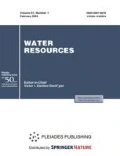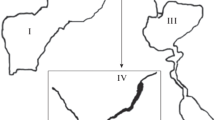Abstract
Data on the Shardarinskoe Reservoir are used to assess the indicator role of zooplankton community under unstable hydrological regime. The structural characteristics of zooplankton featured significant seasonal variations. The averaged indices characterized reservoir water quality at the level of mesotrophic and eutrophic water bodies. The possible use of cyclopidas to characterize toxic pollution of water is discussed.
Similar content being viewed by others
References
Amirgaliev, N.A., Ismailova, Zh.B., Tagaeva, F.E., and Nakupbekov, S.T., Hydrochemical Indices and the Level of Pesticide Pollution of Shardarinskoe Reservoir Ecosystem, in Ekosistemy i rybnye resursy vodoemov Kazakhstana (Ecosystems and Fish Resources of Water Bodies in Kazakhstan), Almaty: Bastau, 1995, pp. 60–69.
Andronikova, I.N., The Use of Structural-Functional Characteristics of Zooplankton in Monitoring System, in Gidrobiologicheskie issledovaniya vnutrennikh vod (Hydrobiological Studies of Inland Waters), Leningrad: Nauka, 1989, pp. 47–53.
Balushkina, E.V. and Vinberg, G.G., Dependence between the Body Length and Mass of Planktonic Crustaceans, in Eksperimental’nye i polevye issledovaniya biologicheskikh osnov produktivnosti ozer (Experimental and Field Studies of Biological Bases of Lake Production), Leningrad: Nauka, 1979, pp. 58–79.
Vinberg, G.G. and Lavrent’eva, G.M., Zooplankton i ego produktsiya. Metodicheskie rekomendatsii po sboru i obrabotke materialov pri gidrobiologicheskikh issledovaniyakh na presnovodnykh vodoemakh (Zooplankton and Its Production: Methodological Recommendations for Collection and Processing of Materials in Hydrobiological Studies of Freshwater Bodies), Leningrad: Nauka, 1984.
Kitaev, S.P., On Relationships between Some Trophic Levels and the Trophic Scales of Lakes in Different Natural Zones, in V s”ezd VGBO. Tez. dokl (V Congress of All-Union Hydrobiological Society), Kuibyshev, 1986, pp. 254–255.
Kryuchkova, N.M., Struktura soobshchestv zooplanktona v vodoemakh raznogo tipa, in Produktsionno-gidrobiologicheskie issledovaniya vodnykh ekosistem (The Structure of Zooplankton Communities in Different Types of Water Bodies), Leningrad: Nauka, 1987, pp. 184–197.
Lazareva, V.I., Succession of the Ecosystem of the Rybinsk Reservoir: Analysis of Data for 40 Years, in Aktual’nye problemy vodokhranilishch (Urgent Problems of Reservoirs), Yaroslavl: Institut biologii vnutrennikh vod, 2002, pp. 171–172.
Malinovskaya, A.S and Ten, V.A., Gidrofauna vodokhranilishch Kazakhstana (Hydrofauna of Reservoirs in Kazakhstan), Alma-Ata: Nauka KazSSR, 1983.
Meshkova, T.M., Zakonomernosti razvitiya zooplanktona v ozere Sevan (Regularities in Zooplankton Development in Lake Sevan), Yerevan: AN ArmSSR, 1975.
Mordukhai-Boptovskoi, F.D. and Riv’er, I.K., Invertebrates as Eutrophication Indicators of Water Bodies, in Nauchnye osnovy kontrolya kachestva poverkhnostnykh vod po gidrobiologicheskim pokazatelyam (Scientific Principles of Quality Control of Surface Waters by Hydrobiological Characteristics), Leningrad: Nauka, 1977, pp. 28–32.
Megarran, E., Ekologicheskoe raznoobrazie i ego izmerenie (Ecological Diversity and Its Measurement), Moscow: Mir, 1998.
Rossolimo, L.L., Antropogennoe evtrofirovanie vodoemov. Obshchaya ekologiya. Biotsenologiya. Gidrobiologiya (Anthropogenic Eutrophication of Water Bodies: General Ecology. Biocenology. Hydrobiology), Moscow: Nauka, 1975, pp. 8–60.
Unified Methods for Studying Water Quality, in Metody biologicheskogo analiza vod (Methods for Biological Analysis of Waters), Moscow: Nauka, 1975.
Khellauel, D.M., Comparative Review of Methods for Data Analysis in Biological Supervision, in Nauchnye osnovy kontrolya kachestva poverkhnostnykh vod po gidrobiologicheskim pokazatelyam (Scientific Principles of Quality Control of Surface Waters by Hydrobiological Characteristics). Leningrad: Nauka, 1977, pp. 108–123.
Krupa, E.G., On the Morphological Deviations of Acanthocyclops americanus Marsh and Cyclops Vicinus uljanin (Crustacea, Copepoda) from the Polluted Water Bodies of Almaty Region (Southeastern Kazakhstan), Russian J. of Aquatic Ecology, 1998, no. 7, pp. 11–16.
Krupa, E.G., A comparative analysis of some Crustaceans Species Inhabiting Polluted Water Bodies, Proc. of 8th International Conference on Copepoda. Keelung: Taiwan Ocean Univ., 2002.
Krupa, E.G., Population Densities, Sex Ratio of Adults and Occurrence of Malformations of Three Species of Cyclopoid Copepods in Water Bodies with Different Degrees of Eutrophy and Toxic Pollution, J. of Marine Science Technol., 2005, vol. 3, no. 2, pp. 1–12.
Maier, G. and Buchholz, R., Zooplankton Communities of Gravel Pits in Relation to Trophy, Dredging Activity and Macrophyte Growth, Limnologica, 1996, no. 4, pp. 353–360.
Author information
Authors and Affiliations
Additional information
Original Russian Text © E.G. Krupa, 2007, published in Vodnye Resursy, 2007, Vol. 34, No. 6, pp. 750–756.
Rights and permissions
About this article
Cite this article
Krupa, E.G. Structural characteristics of zooplankton of the Shardarinskoe Reservoir and their use in water quality assessment. Water Resour 34, 712–717 (2007). https://doi.org/10.1134/S0097807807060139
Received:
Issue Date:
DOI: https://doi.org/10.1134/S0097807807060139



